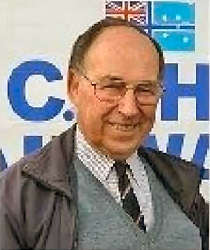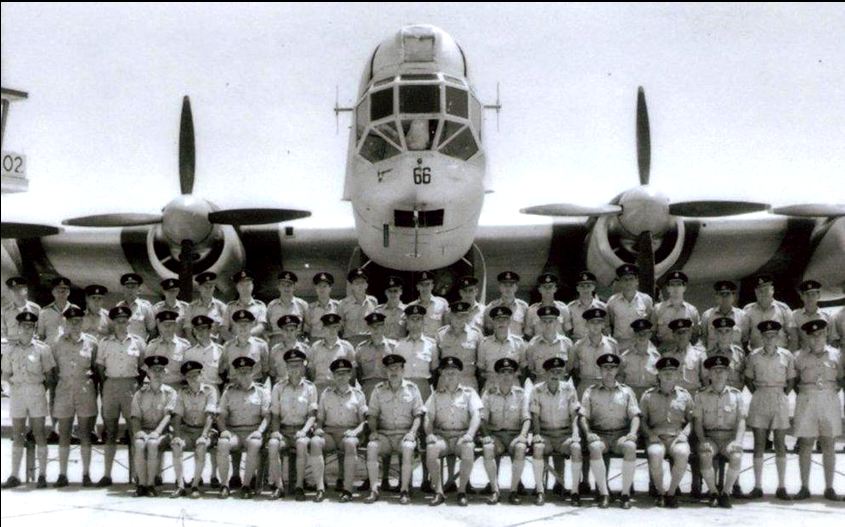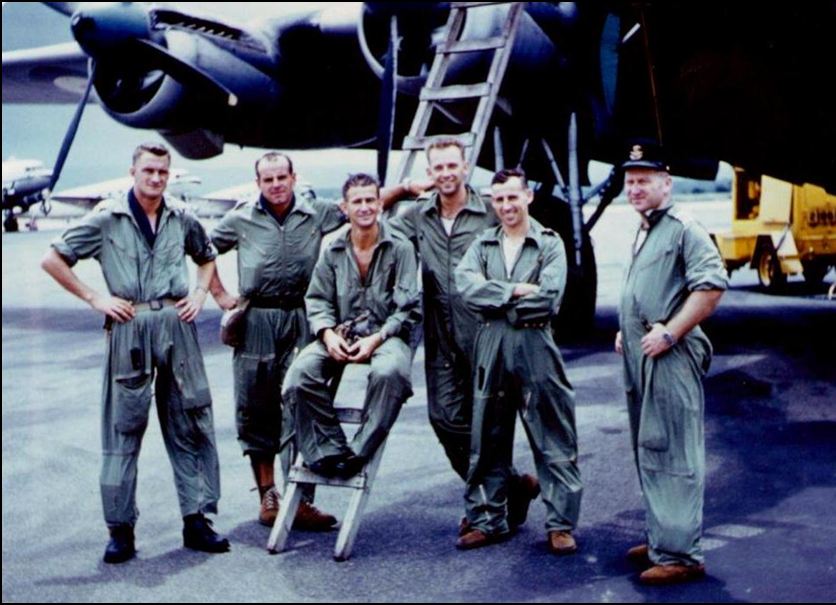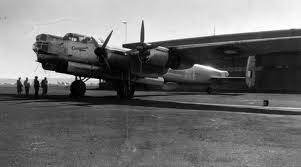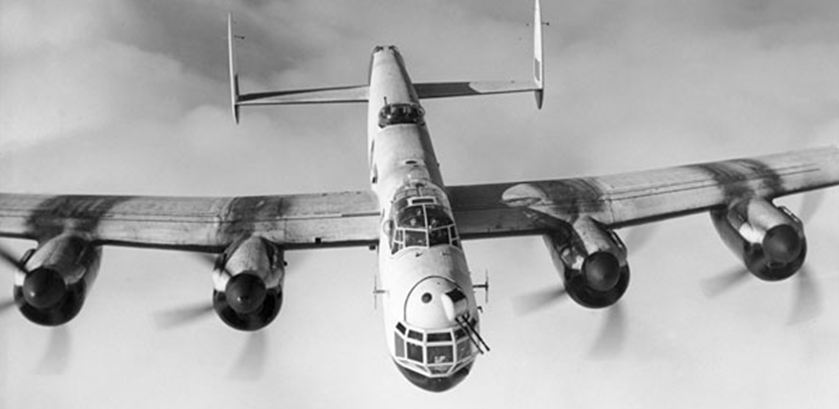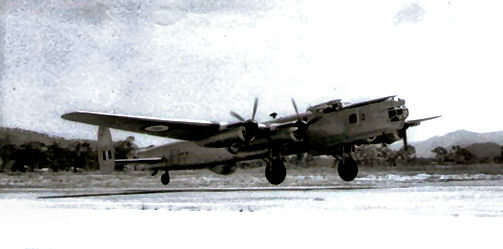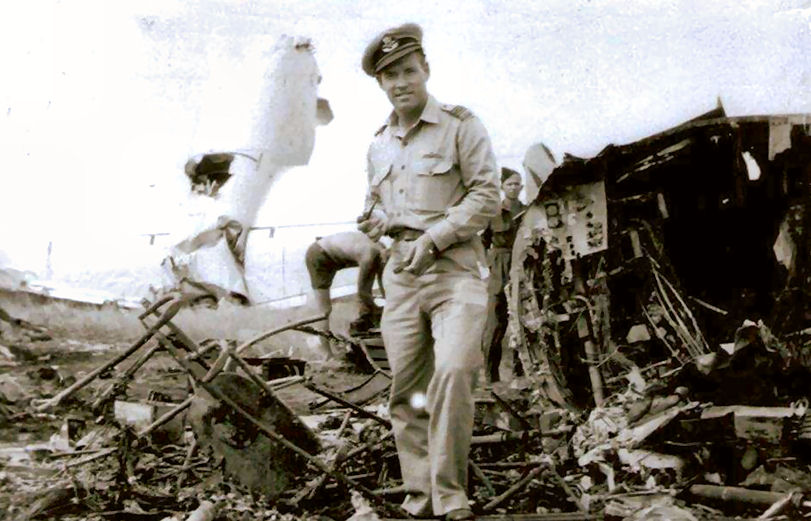|
|
|
|
Radschool Association Magazine - Vol 40 Page 7 |
|
|
Privacy Policy | Editorial Policy | Profit Policy | Join the Association | List of Members | Contact us | Index | Links |
|
|
My Story! |
|
|
Back Go to page: 1 2 3 4 5 6 7 8 9 10 11 12 13 14 15 16 17 18 19 20 Forward |
|
|
|
|
|
FLYING THE Mk 31 "LONG NOSE" LINCOLN
John Laming
The first time I saw a Lincoln bomber was at Townsville in April 1953. There were several on the tarmac at No. 10 Squadron and they looked huge compared with Mustangs and single-seat Vampire fighters I had flown only a few weeks earlier. Having lived in the county of Kent in England for the duration of World War 2, I had heard about RAF Lancaster bombers the forerunner of the Lincoln. With most Lancaster squadrons based in Lincolnshire 140 miles to the north-east, they were rarely seen in my part of England.
|
|
|
|
|
|
Avro Lincoln Mk 31 |
|
|
The Lincoln was designed as a Lancaster replacement, initially for use on long range missions into Eastern Europe and ultimately to equip the Royal Air Force in the Pacific war against Japan. Originally dubbed the Lancaster Mk 4, the extent of the redesign was such that a new type number and name was justified. Apart from Australia, the only export customer for the Lincoln was Argentina. It was also the largest aircraft to be built in Australia. The `Long Nose` Lincoln Mk 31 was unique to Australian manufacture being modified for anti-submarine, anti-shipping and general reconnaissance. It had a 1.9 metre extension to the nose designed to accommodate a tactical navigator, and three sonobuoy operators. Direct opening observation windows which slid up and down on tracks were also in the nose. These windows were fitted with adjustable deflectors which would eliminate wind interference when the windows were open. Four 1680 HP Rolls Royce Merlin Mk 102 liquid cooled power plants were installed.
The bomb bay was modified to carry two homing torpedos, two racks of active sonobuoys and two 188 imperial gallon (855 litres) long range fuel tanks that could be jettisoned. Several freight panniers inside the bomb bay were available if needed. Total fuel capacity including bomb bay tanks was 3226 imperial gallons (14,666 litres). With an average fuel consumption of 230 imperial gallons (1045 litres) per hour the Lincoln had approximately 14 hours endurance. Maximum all up weight was 82,000 lbs (37,200 kgs).
In July 1952 the RAAF Aircraft Research and Development Unit (ARDU) conducted a test flight on a Lincoln Mk 31. The following selected extracts give some interesting insight into the role of the test pilot and into Lincoln flying generally.
|
|
|
Summary
Apart from poor visibility while handling on the ground, there was no great difference in handling from the normal `short nose` Lincoln. It was extremely difficult to taxy on narrow taxy tracks as the edge of the sealed surface could only be seen abeam the aircraft. From the nose position, although the bomb aimer could see ahead, he could not see the wheels so little assistance could be obtained from the front. When lined up on the runway, from either pilot’s position the edge of the runway was observed to intersect the part of the field of vision obscured by the fuselage approximately 100 yards ahead of the aircraft. This lack of visibility made the aircraft difficult to operate at night-time and with the tail down nothing ahead could be seen. The aircraft behaved generally in a very similar manner to the standard Lincoln bomber, however in a yawing or steep sideslip attitude, there was a sudden snatch on the rudder control which resulted in a complete rudder lock. The rudder would lock in the full port or starboard position according to the direction of yaw or skid. Increasing speed would relieve the problem.
|
|
|
When I arrived at Townsville with only 250 hours in my log book I was blissfully unaware of the test pilot’s comments. In any case, having been trained during Pilots Course on the Australian single engine Wirraway our instructors had assured us that if we could fly a Wirraway, we could fly anything. That myth was reinforced when I flew the Mustang shortly after graduation and lived to tell the tale. The Long Nose Lincoln was a different beast altogether as I was soon to find out.
The Commanding Officer of No. 10 Squadron was Wing Commander John “Handlebars” Handbury AFC. He had wide moustache - hence the nickname. The CO was a charming pukka type officer who had flown Lockheed Hudsons during the war against Japanese forces in the South-West Pacific region. He wanted to know what types I had flown.
When told I had flown Mustangs and single-seat Vampires he seemed very pleased because among the Lincoln crews only two had flown the Mustang. There were a couple of former Spitfire pilots and no shortage of ex Lancaster and Halifax pilots. The CO needed another endorsed pilot to fly the squadron Mustang A68-113 on fighter affiliation (mock combat) and gunnery target towing for the Lincolns. I was delighted to oblige, of course. To be able to switch from flying a heavy bomber to haring around the heavens in a Mustang made me a very happy 21 year old. During the interview, the CO explained that because I had not flown a multi-engine type I would fly as second pilot on the Lincoln for nine months or 300 hours before being checked out for local area command.
|
|
|
|
|
|
No. 10 Squadron Aircrew 1960 |
|
|
|
|
|
All being well, another year after that I would be given my own crew and operate as a squadron maritime reconnaissance captain; a far cry from airline pilots of that era where first officers could expect to do 12 to 15 years in the right-hand seat before receiving their first command.
Some squadron pilots, navigators, signallers and air gunners had flown over Europe in WW2. A few wore the golden eagle badge of RAF Bomber Command Pathfinders or the blue and white striped ribbon of the Distinguished Flying Cross. I was in august company, although I did not really appreciate the historical significance until years later when I read stories of their wartime exploits. Meantime I was eager to have my first flight in a Lincoln. There was no ground course; just a case of reading Pilot’s Notes for the RAF Lincoln Mk 1 dated June 1947. There were no official Pilots Notes for the Mk 31 Lincoln.
The Lancaster and Lincoln were originally designed to be flown by one pilot and a flight engineer. Australian Lincolns replaced the flight engineer position with a second or even a third pilot on longer flights. The second pilot was known as the `second-dickey`. The engine starting buttons and engine idle cut-off switches were in front of his position as were the feathering buttons and fire extinguisher switches. Only the captain had flight instruments on his panel. On local flights the pilot often took an airman or another crew member to help start the engines and keep an eye open for other aircraft. The second dickey was responsible for operation of the undercarriage and flaps as well various engine switches situated on the right side of the fuselage adjacent to his rudder pedals. His rudder pedals could be detached to permit crew access to the nose. He sat on a small fold-down stool called a dickey seat which was set lower than the captain’s seat.
|
|
|
|
|
|
|
|
|
The forward view from that position was limited depending on the height of the occupant. To obtain access to the nose compartment from the main fuselage, crew were forced to crawl on their knees under the second-dickey seat, invariably banging their head on his rudder pedals in the process. The later issue of crash helmets called `Bone Domes` significantly reduced sore heads. It was sometimes expedient for the dickey seat occupant to stand up in the aisle, unclip his rudder pedals from their slot, discard them in the nose, stow the seat against the fuselage side-wall and allow crew members to limbo dance under the starboard instrument panel until reaching the relative safety of the front compartment. This was made more difficult with the wearing of parachute harnesses in flight.
In those days there were no written checklists and cockpit drills were learned off by heart using a left to right scan. The final checks for take-off and landing followed the same basic items that were taught at advanced flying training schools and carried over to other types. Naturally there were technical variations between aircraft types and these were discussed during conversion training.
The walk around check was conventional, starting at the rear entrance door and proceeding clockwise around the aircraft. Part of that check was to ensure the rear turret was central and locked. It was also included in the before take-off check if a rear gunner is carried. If the turret is not centralised its drag can cause additional swing on the take-off roll.
|
|
|
Cockpit Layout
Order
of engine start is starboard inner first, then starboard outer, port
inner and port outer. The reason for starting the starboard inner first
is to permit brake pressure to be built up. This can take several
minutes at idle power. An air compressor driven by the starboard inner
engine, charges a
Differential braking is by means of a relay valve connected to the rudder pedals; a common design feature of British designed aircraft of this era. Four 6,000 watt generators (one on each engine) operating a 24-28 volt system, charge four 12 volt aircraft batteries. Each inboard engine has a hydraulic pump that operates the undercarriage, flaps, bomb doors and fuel jettisoning.
Before take off vital actions were standard. Hatches were checked secure. This included rear door closed, mid-upper escape hatch in, cockpit windows closed, nose side windows as desired, nose entrance hatch in. Crew harnesses are secure. The captains seldom wore the shoulder harness. There were no passenger seats so any non-crew occupants grabbed the nearest convenient protuberance. Braced behind the main spar next to the signaller was a favourite spot. Hydraulic pressure was 650-850 PSI, bomb doors closed and fuel jettison lever normal. Trims set to neutral. Throttle and pitch lever friction nuts adjusted. Supercharger MS gear and warning light extinguished, air intake switch cold, air cleaner switch out. Pitch controls full increase RPM. Fuel contents sufficient, master fuel cocks on, cross-feed cock off, fuel booster pumps on, fuel pressure warning lights extinguished. Flaps set one quarter down and selector neutral.
Gyro instruments uncaged and synchronised. Suction correct reading both positions. Magneto switches on and guard locked on. All unnecessary switches off. Automatic pilot off. Brake pressure minimum 190 PSI. Flying controls free movement and in the correct sense. Engine temperatures and pressures within limits for take-off.
Take-Off
Align the aircraft on the runway and check the tail wheel is straight before applying the brakes. Open up to zero boost for ten seconds and check all engines are responding smoothly. Release the brakes gently and smoothly open the throttles to the take-off position of plus 12 boost and 3000 RPM. Emergency power of plus 18 boost is available if needed. There is a tendency to swing left which may be controlled by coarse rudder and differential power leading with the port outer throttle. As speed increases ease the control column forward to raise the tail. Do not attempt to raise the tail by a heavy push force on the control column in the early stages of the take-off run. The aircraft should be eased off the ground at 95-105 knots depending upon weight. After airborne, brake the wheels gently and retract the undercarriage. The take-off safety speed at all weights is 120 knots. When safety speed is attained select 2850 RPM. Above 300 feet raise the flaps in stages while being aware of the nose-down change of trim. Allow speed to increase to 140 knots as the flaps retract. Reduce power to plus 9 boost and 2650 RPM and turn off all main booster pumps off.
Climb
Normal climb speed is 140 knots sea level reducing to 126 knots above 22,000 ft. If climbing to high altitude at maximum climbing power, set the supercharger gear change to AUTO and switch on the booster pumps above 17,000 ft. The supercharger will cut in with an audible `thump` around 17,000 ft.
|
|
|
I'm supposed to respect my elders, but it’s getting harder and harder for me to find one now.
|
|
|
General Flying
Stability is satisfactory under all conditions. The elevator is relatively light and effective but tends to become heavy in turns. The ailerons are moderately light but somewhat spongy at cruising speeds. They become increasingly heavy at speeds above 245 knots and lose some effectiveness at high altitude. The rudders are effective but become very heavy at speeds above 245 knots.
|
|
|
Change of Trim.
|
|
|
|
|
|
|
|
|
Stalling
Warning of the stall is given by tail buffeting which can be felt some five knots before the stall itself. The stall is gentle and recovery straight forward.
Approach and Landing
When I first flew a Lincoln I had problems judging the flare height because of the lofty position of the cockpit above the ground. I had been used to flying the Vampire where the pilot’s eye height was little more than five feet above the runway. With the help of various captains, some understandably nervous with a sprog second pilot, I eventually ironed out my problem. In doing so, I ironed out a few runways as well.
With full flap the threshold speed varies between 90 – 95 knots depending on weight. A flapless landing is made at 110 knots and at least 6000 ft of runway is needed to avoid the risk of complete brake failure caused by the expandable brake bags overheating. For this reason practice flapless landings were made using the touch and go method of landing. To carry out a normal landing, after turning on to base leg, the power should be reduced to approximately zero boost. Aim to be lined up on final at 5-600 ft AGL and use flaps as required. Maintain 120-125 knots until on final. The speed should then be progressively reduced to cross the threshold at 100-105 knots. At the same time, power should be gradually reduced to minus 4 boost on final and fully closed at the flare. A three point landing is easily achieved although an inadvertent tail wheel first touchdown may cause initial directional control difficulty.
A main wheel landing at night is recommended due to the poor forward vision from the cockpit. As with any conventional (tail-wheel) aircraft, cross-wind landings require prompt corrective action to prevent a swing developing after the tail is lowered. If brake application in conjunction with corrective rudder is insufficient to prevent a swing into wind, differential power using the outboard engines may be required. During taxying after landing, it is important to monitor the brake accumulator pressure as the charge rate is slow at idle RPM. The radiator coolant shutters should be set to open for taxiing.
Night landings are difficult to judge because of the lack of forward visibility as the tail is lowered, particularly in cross-winds. Pilot techniques vary and some find it advantageous to open the pilot’s sliding side window after touch-down and lean outside the cockpit to get a better forward view. If using this technique, flying goggles should be used to prevent eye damage. When landing from the second pilot’s position, the forward view is worse since the `dickey` seat is simply a folding stool set at a lower height than the captain’s, which is on a raised pedestal. The only flight instruments were for the captain. The second pilot was forced to lean over to see the captain’s instruments and on final approach allowance had to be made for parallax error using the captain’s ASI. Occasionally a crew member was briefed to open the second pilot’s sliding window on touch-down to avoid the landing pilot having to relinquish his hold on his control column in order to open his own window. Earlier comments by ARDU test pilots that the Lincoln Mk 31 would be difficult to operate at night time because of poor visibility on the ground, is the understatement of the year!
|
|
|
Going Around
The
aircraft will climb away satisfactorily at maximum landing weight using
climb power with undercarriage and flap down. Power should be increased
to plus 12 boost and 2850 RPM
Result of a go-around on three engines, below minimum control speed.
At a safe height raise the remainder of the flap. It is essential to raise the flap to half down before the undercarriage is selected up, otherwise an uncontrollable nose-up change of trim may be experienced at loadings near the aft centre of gravity limit; this is aggravated by the use of full power. Test flying of the Lincoln Mk 31 before squadron service included a two engine go-around at speeds between 105 and 90 knots. With maximum power of plus 18 boost, undercarriage and full flap down, there was sufficient elevator control to carry out the overshoot, although at 90 knots there was only an estimated inch of forward stick travel left.
In later years as squadron QFI, I had a close call during circuit training at night. The pilot had less than 300 hours and was new to multi-engine aircraft.
The exercise called for simulated feathered landings with the `dead` engine throttled back just enough to simulate the drag from a feathered propeller. This meant instant power was available to all engines should the pilot bounce badly enough to require a go-around. Two earlier crashes wrote off both aircraft during practice asymmetric landings with a feathered outboard propeller. Following botched touch-downs the pilots had lost control of the aircraft after going around on three engines below minimum control speed. After that the RAAF prohibited practice feathered landings.
On the night in question the student coped well with a practice failure of the port outer engine, which after identification, was throttled back to minus 4 boost to simulate zero thrust. On the downwind leg the student requested undercarriage down and one quarter flap which was standard asymmetric configuration. When I selected the flap lever as requested, it broke away in my hand leaving the hydraulic selector valve under the cockpit floor moving to the full flap position. As described earlier, Pilots Notes for the Lincoln warned that on a go-around with full flap, immediate flap retraction to half flap was needed to avoid a strong nose up change of trim. Failure to take immediate action could lead to the nose rising and loss of forward elevator effectiveness. On three engines this could be dangerous due to rapid loss of airspeed and rudder effectiveness. In our case the flaps went full down and up went the nose with a vengeance. Taking over from the student who was initially unaware of what had happened, I was able to increase power on the port outer from zero thrust to take off power, along with the other three engines.
As expected this aggravated the pitch up. With a rapidly deteriorating airspeed we were damned if we did and damned if we didn’t. To maintain level flight with full flap down the control column was almost on its forward stop. It didn’t help that from the instructor’s seat I was forced to lean well over to see the captain’s instruments which at night were difficult to read accurately because of parallax error and low cockpit lighting. There was a 700 ft hill on base leg and once past that, I was able to start descent on final at normal approach power of zero boost. The landing was normal thereafter. I was thankful for that, since the flaps were now fixed at full down, and a go-around was the last thing we needed as there was no means of retracting the flaps. It followed that the pitch up problem would re-occur if full power was applied. But at least we would be ready for it this time.
I served two tours covering 3000 hours on Lincolns. By modern standards their Rolls Royce Merlin engines were not all that reliable with glycol coolant leaks a common reason for closing down an engine in flight. In the tropics, early versions of the Merlin engine occasionally suffered blow-backs on take-off which destroyed the superchargers and causing instant engine failures. Log book records reveal in the five years I flew Lincolns I had 32 engine failures, including several during take-off. Some of these were precautionary engine close-downs to prevent over-heating due to coolant leaks.
|
|
|
|
|
|
|
|
|
No. 10 Squadron at Townsville was the final operational unit to fly Lincolns in RAAF service and the only one to operate the `long nose` Mk 31. By 1961, its Lincolns were well and truly the last in service with the RAAF and their days were numbered following the discovery of advanced corrosion in the wing spars of the remaining aircraft. All Lincolns were grounded immediately; the final flight taking place on 14 June 1961 when A73-65 was ferried to Darwin for use on that airfield’s fire dump, a perhaps unfortunate end to the aircraft’s career in RAAF service.
I am grateful to Mr Stewart Wilson for the use of extracts from his book “Lincoln, Canberra and F-111 in Australian service”. Other selected extracts came from “Testing Times” by test pilot John Miles.
|
|
|
Going to church doesn't make you a Christian any more than standing in a garage makes you a car.
|
|
|
|
|
|

